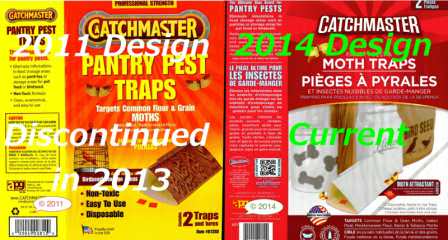At TrapsDirect.com our goal is to help solve your moth infestation problem without chemicals, pesticides or anything that could hurt you or your family.
Moth control troubles are not a result of poor housekeeping! This century moth invasions are a by product of our global food chain. Rice you may have in your pantry, dutifully bagged and air tight was probably dried in the open air of some other country. That means bugs, moths etc, had weeks to wander into your food, set up shop and wait for a ride to your pantry.
We only recommend natural, non-toxic solutions since the moths are near your (or your pet’s) food supply.
We never recommend using pesticides, poisons or other chemical for moth extermination projects.
The gold standard for defeating moth invasion is pheromone moth traps because the sticky moth trap uses moth pheromone that emulates the mating scent of the female moth, which attracts male moths. For every Male indian meal moth caught, you reduce the next generation of moth larvae that will grow into adults. Let’s look at the steps for getting rid of a moth infestation
Pesticide Free Moth Extermination
4 simple steps to resolve any size moth problems
1. infested foods into the garbage!
This is the hardest part, because it is the most expensive. Empty your cupboard!
Any open foods you only use a little at a time of like corn meal, corn starch or oatmeal need to go. If you want to be more conservative, check for clumping of the grain or powders. If you find clumps you know there are moth eggs, or moth larvae are living in the food, and using it as an all-you-can-eat buffet. Throw it away.
Even though it may cost a few dollars, throw out any contaminated foods including the packages.
No arguments, if you try to empty out part of the container you will end up leaving moth larvae and eggs that you can’t see and your moth problem will never end.
2. Clean to remove all moth larvae webbing
Next we head for all of the non-food target areas. Cracks, crevices, grooves, even the inside of the pantry door trim.
At this point your cupboard should be empty. Remove all shelf liner and if shelves are removable take them out too.
Your goal is to remove the larvae and webbing. Clean using paper towels, and throw them away when they become matted with webbing. Pay close attention to the inside trim of the pantry, underside of shelf supports and even the shelf adjustment peg holes.
Clean EVERY inch of the pantry making sure Larvae and webbing is not on the ceiling or underside of solid shelves. Moth are notorious for hiding everywhere… If you don’t get them all, you’ll be re-cleaning in a few months.
Glass Jars and Cans you removed in step one can be wiped down completely and restocked in the pantry.
3. Deploy Pheromone Traps to catch Adult male moths
With cleaning and restocking completed, you will have physically removed all of the moth larvae, moth eggs, moth pupa and the adult moths that were in the pantry. What remains is to prevent the next generation. Once the male pantry moth can fly, it no longer eats, or has interest in food. After a period of time as a flying juvenile male indian meal moth will shift its attention to procreate the next generation of moths. The use of Pantry Moth Traps is designed to capture adult male moths, thus preventing reproduction, and interrupting the next wave of pantry moths. We recommend using moth pheromone traps that are effective to capture breeding age adult male moths ( those ready to mate)
This means that not all moths will be trapped. That’s ok, don’t be discouraged when you see moths flying past the traps! It could be female moths, who won’t be attracted to the moth trap or it could be young adult moths who are not ready to mate. Allow a couple weeks (most moth traps will remain active for 12 weeks) and your traps will attract the moths that are the most dangerous, the moths that want to mate and create the next wave of infestation.
4. Repeat monthly (ish)
Monthly (ish)??? What does that mean? The Pantry moth lifecycle varies based on time of year, and temperature. So in July a wave of moths may arrive every 4-5 weeks (monthly) where as in December you might think you have the pantry pests beat, because they slow to 6-8 weeks life cycles. Either way, until you break the infestation they will keep coming back.
Moth control requires multiple cycles of moth control. The reason? If moth traps catch half the adult male moths, there are still another half that can find females and mate. So after the first wave your moth infestation will be down to 50%, after the second wave you are down to 25%, and the third wave reduces the infestation to 12%. By the time the infestation is down to this small size, the odds that a male moth can physically find a female to reproduce with are even lower. At this point your moth infestation will be under control.
If you initial infestation was smaller, then you will have things under control faster. Once the problem is solved, keep a sentinel moth trap to let you know when an infestation is imminent. The practice of keeping 1 pantry moth trap at all times is called a sentinel strategy. When the sentinel moth trap has a few moths in it, jump to action, repeat this process and you can get rid of moths before they have a chance to mount another home invasion!


I had heard somewhere that using mint or bayleafs in the cupboard would also get rid of moths.. Is that true?